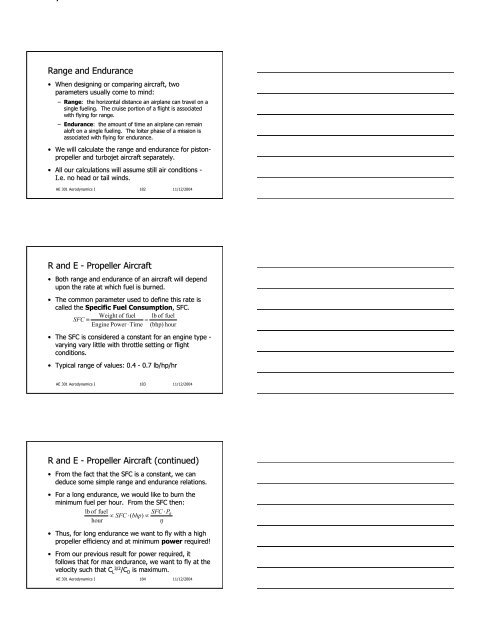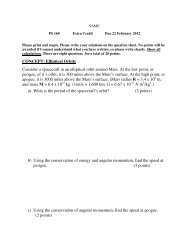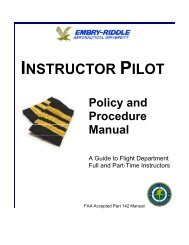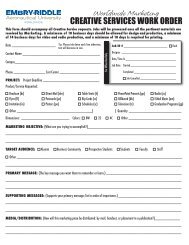You also want an ePaper? Increase the reach of your titles
YUMPU automatically turns print PDFs into web optimized ePapers that Google loves.
R and E - Jet Aircraft (continued)• From the fact that the TSFC is a constant, we candeduce some simple range and endurance relations.• For a long endurance, we would like to burn theminimum fuel per hour. From the TSFC then:lb of fuel∝ TSFC ⋅(lb of thrust)hour• Thus, for long endurance on a jet, we want to flywith a minimum thrust required!• From our previous result for thrust required, it followsthat for max endurance, we want to fly at thevelocity such that C L /C D is maximum.<strong>AE</strong> <strong>301</strong> <strong>Aerodynamics</strong> I 19411/12/2004R and E - Jet Aircraft (continued)• For a long range, we would like to burn the minimumfuel per mile traveled. Dividing our previous result byvelocity (miles/hour) gives:lb of fuel TSFC ⋅(lb of thrust) TSFC ⋅TR∝∝mileVV• To reach a conclusion from this relation, lets assumeT R =D and substitute velocity from our C L definitionTRDW1C= =SCD=2ρ∞SWV VSCC∞∞1 122ρ∞V∞SCD=2ρ∞ρ∞• Thus, among other things, for max range we want tofly at a velocity such that C 1/2 L /C D is a maximum!∞L∞D1/ 2L<strong>AE</strong> <strong>301</strong> <strong>Aerodynamics</strong> I 19511/12/2004R and E - Jet Aircraft (continued)• Now let’s s work at the quantitative relations.• First, since TSFC does not have consistent units, anew fuel burn rate is introduced:c tlb of fuel≡=(lb of thrust) sec1sec• Note that c t is the same in either unit system.Converting to TSFC results in:c =• As before, always check units and conversion factorswhen using other references!<strong>AE</strong> <strong>301</strong> <strong>Aerodynamics</strong> I 196tTSFCsec( 3600 )hour⎛⎜⎝c tN of fuel≡ =( N)sec11/12/20041sec⎞⎟⎠
R and E - Jet Aircraft (continued)• The rate at which jets burn fuel is given by:dW = dW = −c Tdt• Rearranging and integrating for endurance gives:tW110dWdWE = ∫ dt = ∫E =− c0 W0tT∫ctW1tT• Similarly, range will be calculated by:x11V∞dWR = ∫ dx = ∫− c Tx0WW0• Note how similar these equations are to those forpropellers - only the denominator is different.<strong>AE</strong> <strong>301</strong> <strong>Aerodynamics</strong> I 197tftR =WW0V∫ ∞cW1dWtT11/12/2004Breguet Jet Equations• Now make assumptions similar to those for propellerspreviously to get the Breguet Jet equations fromthese integral relations.• For endurance, assume steady, level flight so thatL=W and T=T R =D.W0W0W0dW WdW L dWE = ∫ =c T∫ =c DW∫cD WW1tW1tW1t• Now with c t a constant and assuming the aircraft isflown at a velocity such that L/D = C L /C D remains aconstant.<strong>AE</strong> <strong>301</strong> <strong>Aerodynamics</strong> I 19811/12/2004Breguet Jet Eqns (continued)• Pulling out theses constants and integrating yields:1 CE =c CLt D⎛W⎞oln⎜⎟⎝ W1⎠• This relations tells us that to maximize endurance,we want:– The lowest possible thrust specific fuel consumption– The largest possible weight fraction of fuel, W f /W– A large (L/D) max and to fly at the velocity where this isachieved.<strong>AE</strong> <strong>301</strong> <strong>Aerodynamics</strong> I 19911/12/2004
Breguet Jet Eqns (continued)• Perform a similar procedure with the jet rangeequation.W0W0W0V∞ dW V∞WdWV∞L dWR = ∫ =c T∫ =c DW∫c D WW1W1• To go further, relate velocity to lift via:V∞ = 2W/( ρ∞SC L)W• Now assume that c t and ρ ∞ are constant, and thatthe aircraft is flown at a velocity such that C 1/2 L /C <strong>Dr</strong>emains a constant<strong>AE</strong> <strong>301</strong> <strong>Aerodynamics</strong> I 200T0CL2WdWR = ∫ =c C ρ SC WW1tD∞LtW0∫W1W1tC1/ 2c CtLD2 dWρ S W∞1/ 211/12/2004Breguet Jet Eqns (continued)• With these assumptions, integration yields:2 CLR =c Ct1/ 2D2Sρ ∞2 2( W1/ −W1/ )• This relations tells us that to maximize range, wewant:– The lowest possible specific fuel consumption– The largest possible weight fraction of fuel, W f /W– A large (C 1/2 L /C D ) max and to fly at the velocity where this isachieved.– Flying at the lowest density possible, I.e. high altitude!01<strong>AE</strong> <strong>301</strong> <strong>Aerodynamics</strong> I 20111/12/2004Breguet Eqns - Summary• Here is a summary of the Breguet equations:• For piston-propellers:propellers:η CR =c CLD⎛W⎞oln ⎜⎟⎝ W1 ⎠EηC3/ 2=LcCD∞ 2⎛ 1 12ρS⎜ −1/ 2 1/⎝W1W0⎞⎟⎠• For turbojets:2 CLR =c Ct1/ 2D2ρ S∞2 2( W1/ −W1/ )011 CE =c CtLD⎛W⎟ ⎞oln⎜⎝ W1⎠<strong>AE</strong> <strong>301</strong> <strong>Aerodynamics</strong> I 20211/12/2004
C L and C D relations - Summary• For (C 3/2 L /C D ) max , C D,iCCL= 3πeARCD,0C• For (C L /C D ) max ,C=πLeARC D,0D,i =3C D,03/ 2LDC D,i =C D,0• For (C 1/2 L /C D ) max , C D,i =1/3 C D,0CL πeARC D13,0D=CL1=C 2( 3πeARC)4C3/ 4D,0D,0πeARCD,01/ 2 1(,0)=CL3πeARCDCD=43CD,01/ 4<strong>AE</strong> <strong>301</strong> <strong>Aerodynamics</strong> I 20311/12/2004Accelerated Flight• Thus far, all the performance parameters we haveconsidered have been for an aircraft in unacceleratedflight - so called static performance.• Now lets begin to consider the performance of anaircraft experiencing accelerations - either along orperpendicular to the flight path.• For the first case - accelerations along the flight path- we will consider the two most extreme situations:takeoff and landing.• For the second - accelerations normal to the flightpath - we will consider turning flight.<strong>AE</strong> <strong>301</strong> <strong>Aerodynamics</strong> I 20411/12/2004Takeoff Performance• An aircraft under acceleration must obey Newton’ssecond law:F = ma or a = Fm• If we further assume that the force and thus theacceleration is constant, then by successiveintegrations over time we can get:V = at or t = V = Vma F( )( Vm2 21 21s =F ) V m2at or s =2=m F 2F• In these relations, t and s, are the time and distancerequired to achieve a target velocity, V.<strong>AE</strong> <strong>301</strong> <strong>Aerodynamics</strong> I 20511/12/2004
Takeoff Performance (continued)• Now let’s s concentrate on our particular situation asillustrated below:LDTRW• In addition to the familiar forces of L, W, T, and D,we also have a ground resistance force, R.<strong>AE</strong> <strong>301</strong> <strong>Aerodynamics</strong> I 20611/12/2004Takeoff Performance (continued)• This resistance force is due to the rolling frictionbetween the tires and the ground.• Assume this force is proportional to the normal forceof contact:R = µr( W − L)• The friction coefficient used here, µ r , will also dependupon the type of runway surface. Typical values are:µ r = 0.02 for smooth, hard runway (asphalt or concrete)µ r = 0.1 for grass runway (unmowed(and uncompressed)• With this new force, a summary of the forces in theflight path direction gives:<strong>AE</strong> <strong>301</strong> <strong>Aerodynamics</strong> I 207( W L)F = T − D − R = T − D − µr−11/12/2004Takeoff Performance (continued)• One special note concerning drag applies to bothtakeoff and landing.– Due to the interaction of the ground, the wing tip vorticesare weakened.– The result is both an enhanced lift, and a decreased induceddrag - this is called the ground effect.– To account for this drag decrease we will use:2⎛ C ⎞LD = q ∞S⎜C⎟D,0+ φ⎝ π eAR ⎠where φ depends upon the height of the wing above theground, h, and the wing span, b:2( 16h/ b)φ =0 ≤ φ ≤11+16h/ b( ) 2<strong>AE</strong> <strong>301</strong> <strong>Aerodynamics</strong> I 20811/12/2004
Takeoff Performance (continued)• If the airplane forces are plotted schematically for ajet aircraft (fighter), we would see something like:• Note that all our forcesvary as the aircraftgains speed.• The net axial force alsovaries, but not as much.• Thus, is is reasonable toreplace this net forcewith an average value.ForcesWTT-D-µ(W-L)D+µ(W-L)LDµ(W-L)s LOs<strong>AE</strong> <strong>301</strong> <strong>Aerodynamics</strong> I 20911/12/2004Takeoff Performance (continued)• Thus, assuming that thrust is nearly constant, we candefine an effective axial force.[ D + ( W − L)] constFeff = T − µr=• To determine an average value for the resistanceforces, D and R, it is suggested that the value at 0.7the lift off velocity is used:[ + µ ( W − L)] = D + µ ( W − L)• And, in turn, the lift off velocity is typically 1.2 timesthe stall speed at takeoff:2WVLO= 1.2Vstall,TO= 1.2ρ SCavg[r]0. VLO<strong>Dr</strong>avg7∞L,max,TO<strong>AE</strong> <strong>301</strong> <strong>Aerodynamics</strong> I 21011/12/2004Takeoff Performance (continued)• Putting all these assumptions together finally gives usthe take off ground roll distance:orssLOLOV m= =2 22LOFeff2VLO( W / g)[ D + µ ( W − L)]{ T −}21.44W=gρ ∞SCµL,max• One final assumption Anderson notes is when thethrust is much greater than the resisting forces. Forthis case:21.44WsLO=g ρ∞ SC Travg{ T − [ D + ( W − L)] }L,maxravg<strong>AE</strong> <strong>301</strong> <strong>Aerodynamics</strong> I 21111/12/2004
Takeoff Performance (continued)• To summarize our results for take off performance:sLO21.44W=gρ ∞SCµL,max– Takeoff distance increases with the square of aircraftweight!– If thrust variations with altitude are included, T ∝ ρ ∞ , thentakeoff distance increases inversely with the square ofdensity, s ∝ 1/ρ ∞2 !– Takeoff distance decrease with higher wing area, S, orhigher takeoff C L,max .– Takeoff distance decreases with either higher thrust orreduced ground resistance.<strong>AE</strong> <strong>301</strong> <strong>Aerodynamics</strong> I 212{ T − [ D + ( W − L)] }ravg11/12/2004Takeoff Performance (continued)• One final note: the FAA regulations for aircraft donot specify takeoff distance by the ground roll, but bythe distance needed to clear an obstacle:s LOs TO or s TOFLh = 50ft (FAR 23)or 35ft (FAR 25)• For small propeller airplanes (FAR 23 certified), agood approximation is to assume s TO =1.7s LO .• For large transport aircraft (FAR 25 certified) boththe regulations and aircraft performance is morecomplicated - see other references for details!<strong>AE</strong> <strong>301</strong> <strong>Aerodynamics</strong> I 21311/12/2004Landing Performance• Calculations for landing performance are very similarto those for takeoff performance.• The primary differencesare:– Most airplanes land withthe engines at idle - T ~ 0.– The aircraft starts with aninitial touchdown velocity,V T , and decelerates torest.– The resistance forces,drag and ground frictionare intentionally large.ForcesWDLD+µ(W-L)µ r (W-L)s Ls<strong>AE</strong> <strong>301</strong> <strong>Aerodynamics</strong> I 21411/12/2004
Landing Performance (continued)• The balance of forces now gives:0dVF = T − D − µr( W − L)= mdt• And, as with takeoff, we will assume a constantaverage axial force can be defined by:[ D + µr( W − L)] = −[ D +r( W − L)]avg0. VTFeff= −µ7• The distance relation is the same except for anegative sign to account for starting with velocity V Tand decelerating to rest:2VTmsL= −2Feff<strong>AE</strong> <strong>301</strong> <strong>Aerodynamics</strong> I 21511/12/2004Landing Performance (continued)• Putting all these together gives the relation:22VTm VT( W / g)sL= =2F2 D + µ ( W − L)• Anderson assumes that touch-down will occur at 1.3times the stall speed at landing, such that:– or whenTeffV = 1.3VCstall,LL,max,LCL,L==[ r] avg2W= 1.3ρ SCC∞L,max,LL,max,L2( 1.3) 1. 69<strong>AE</strong> <strong>301</strong> <strong>Aerodynamics</strong> I 21611/12/2004Landing Performance (continued)• With this, our final landing distance relations is:21.69WsL=gρ ∞SC µL ,max, L[ D + r( W − L)] avg• To increase the resisting forces and thus shortenlanding distances, a number of force enhancingmethods are used:– First, brakes are normally applied. This has the effect ofincreasing the rolling friction. For paved, dry runways, avalue of µ r =0.4 is typical.– Also the profile drag associated with landing flaps isintentionally high - thus increasing C d,0.<strong>AE</strong> <strong>301</strong> <strong>Aerodynamics</strong> I 21711/12/2004
Landing Performance (continued)– Spoilers are used on many aircraft. These upper surface,split flap like devices act to abruptly decrease the wing liftonce on the ground which helps to improve the rollingfriction. Spoilers also increase the profile drag.– <strong>Dr</strong>ag chutes use to be common on high performancefighters. And of course landing arresting systems such as oncarrier ships can be used.– Finally, many airplanes can produce reversed thrust eitherthrough a mechanical system on jet engines or reversedprop pitch on piston/turboprop engines. To include reversedthrust, simply add in this term with the other resistingforces:21.69WsL=gρ ∞SC T + D + µ ( W − L)L,max,L<strong>AE</strong> <strong>301</strong> <strong>Aerodynamics</strong> I 218{ [ ] }Rravg11/12/2004Landing Performance (continued)• Finally as with takeoff, the FAA regulations foraircraft do not specify landing distance by the groundroll alone, but include the distance needed to clear anobstacle before landing:h = 50ft (FAR 23)or 50ft (FAR 25)s LG• In addition, for FAR 25 certified aircraft, the FAAdefines a landing field length, S FL , as S L /0.6. Thisprovides an additional safety factor to account forpilot technique.s L<strong>AE</strong> <strong>301</strong> <strong>Aerodynamics</strong> I 21911/12/2004Turning Flight• Now consider situations where the acceleration isnormal to the flight path. The most important ofthese is banked turn as illustrated below.φLF rRW• A side force, Fr, is generated by banking the aircraftand tilting the lift vector.• This side force acts as to produce centripetalacceleration that pulls the aircraft around in an arc ofradius R<strong>AE</strong> <strong>301</strong> <strong>Aerodynamics</strong> I 22011/12/2004
Turning Flight (continued)• Note that since the lift vector is tilted by the bankangle, φ, , to maintain level flight, the lift force mustexceed the weight according to:L cosφ = W• If we define a load factor, n, as the ratio of lift toweight, then by vector math:Ln = 2 22W F r= L −W= W n −1• Thus, the centripetal force is related to the loadfactor.LF rφW<strong>AE</strong> <strong>301</strong> <strong>Aerodynamics</strong> I 22111/12/2004Turning Flight (continued)• From physics, we know that thecentripetal force is calculated by:2V∞F r= mR• Thus, the turn radius, R, is a function ofthe aircraft velocity and load factor:22V∞V∞R = m =F2r g n −1θR• Similarly for the turning rate:2dθV∞g n −1ω = = =dt R V<strong>AE</strong> <strong>301</strong> <strong>Aerodynamics</strong> I 222∞11/12/2004Pullup Maneuver• In a pullup maneuver the aircraftsuddenly experiences an increasein lift above that necessary tosupport the weight.• This is normally achieved byrotating the craft up to a higherangle-ofof-attack through use ofthe elevator control surface.• As a result of the imbalance offorces in the vertical direction, theflight path begins to curveupwards as shown in the sketch.<strong>AE</strong> <strong>301</strong> <strong>Aerodynamics</strong> I 223θLW11/12/2004R
Pullup Maneuver (continued)• The centripetal force for this maneuver is now in thevertical plane:= L −W= W ( n −1)F r)• The radius of curvature of the flight path and thepitch-up rate are similarly given by:R2V V=F g(n −12= m∞ ∞rV∞g(n −1)ω = =R V∞• Note that these relations are equally valid for apushover maneuver - a “pullup” with n < 1.0.<strong>AE</strong> <strong>301</strong> <strong>Aerodynamics</strong> I 22411/12/2004Pulldown Maneuver• The pulldown maneuver is theinverted form of the pullupmaneuver.• In this case, both lift and weightare contributing to the pitch rate- as a result, simply rolling anairplane inverted will initiate thismaneuver.• By convention, we will stillconsider lift and thus load factorpositive as sketched.LWθR<strong>AE</strong> <strong>301</strong> <strong>Aerodynamics</strong> I 22511/12/2004Pulldown Maneuver (continued)• Since the lift and weight are now in the samedirection, the downward acting centripetal forces is:F r= L + W = W ( n +1)• And the flight path radius of curvature and pitchdown rate are given by:22V∞VV∞∞g(n + 1)R = m =ω = =F g(n + 1)R V∞r• Note that as long as n > -1, R and ω are positive -for n=-1 1 the plane is in level flight; for n < -11 theplane begins climbing in a “pushup” maneuver.<strong>AE</strong> <strong>301</strong> <strong>Aerodynamics</strong> I 22611/12/2004
Maneuver Summary• A highly maneuverable aircraft is one for which themaneuver radius, R, is small and the turn/pitch rate,ω, , is large.• To achieve this, all the equations derived so farindicate that a low velocity and high load factor aredesirable!• High load factors, of course, require strong structures- but the maximum load factor also depends uponthe C L,max of the aircraft and it’s s flight velocity.• To see how load factor and velocity are inter-related,related,we use a so-called V-n V n diagram.<strong>AE</strong> <strong>301</strong> <strong>Aerodynamics</strong> I 22711/12/2004
















